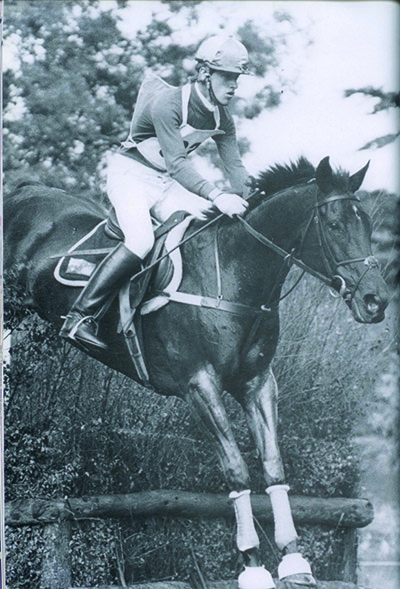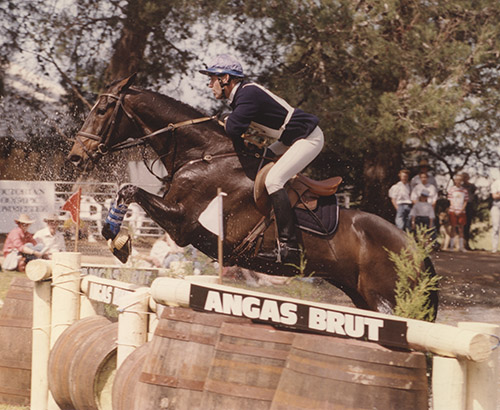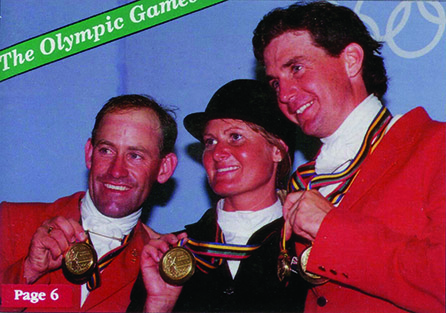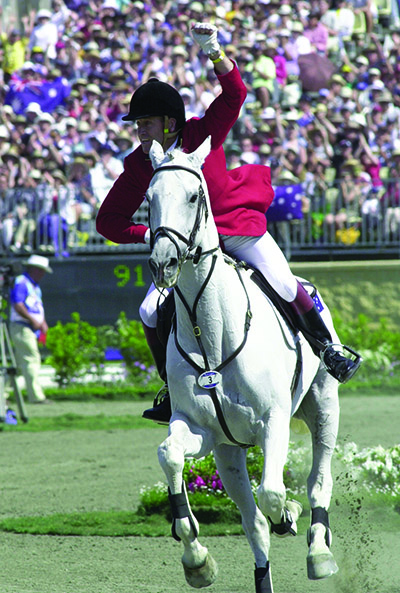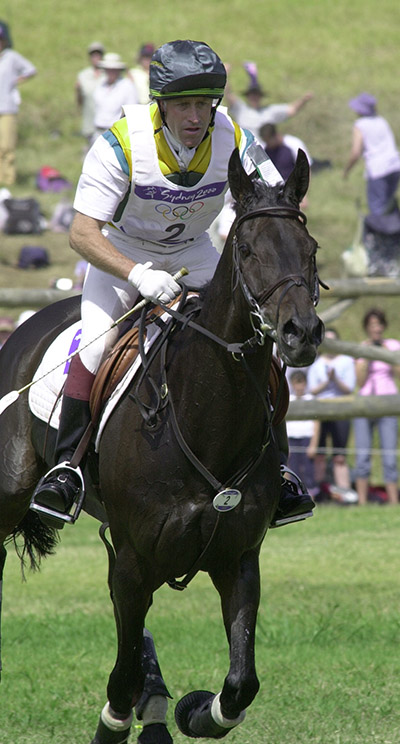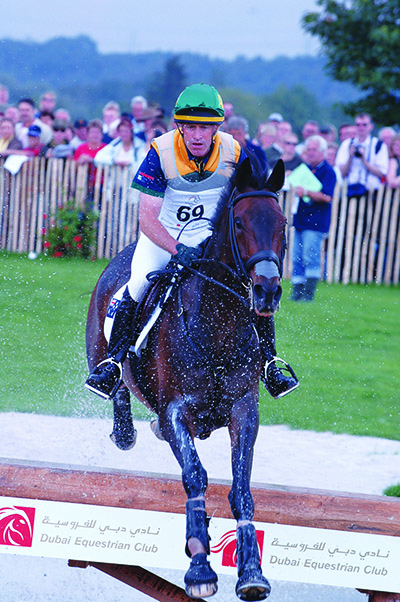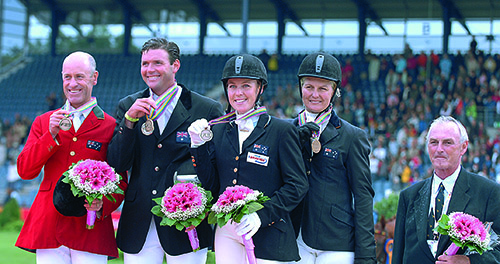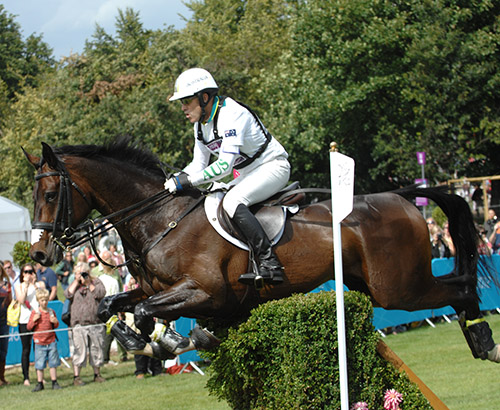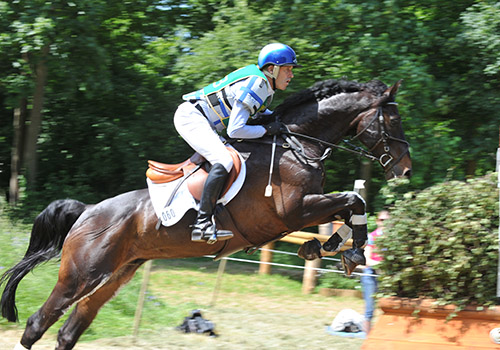Chris Hector interviews Andrew Hoy
Andrew and Davey win Burghley Horse Trials, 1979
Andrew competed in his first World Eventing Championships back in 1978, at the age of nineteen, on Davey, the little Stockhorse, he met up with when he was just seventeen years old. They were eliminated on the cross country on a day when the humidity and toughness of the track resulted in 38.29% of the starters being withdrawn / eliminated / retired on the cross country. But Andrew was a fast learner, the following year, Andrew and Davey won Burghley and Andrew has been part of the world’s eventing elite pretty well ever since… If it is a major four star – Badminton, Burghley, Lexington – then Hoy Boy has been there, done that, WON that. At the 2012 Olympic Games in London, he became the first Australian athlete to compete at seven Olympic Games.
It was great then to spend some time with Andrew on his recent visit to Australia, to get his thoughts on the way the sport has evolved in the past thirty plus years, refreshing too, to discover that Andrew has lost none of his enthusiasm and drive in the process.
You made your name riding a Stockhorse, and then consolidated your career with a Thoroughbred, but now your two front-liners are German Warmbloods – is this a reflection of how the sport is changing?
“It definitely has changed. When I started there were roads and tracks, and the steeplechase. I didn’t compete when there was Phase E after the cross country, a cooling down period… But I think it has changed for me, not just because of the way the sport has changed, the move from the longer format to the shorter format, but it is also because I am now based in Europe and have access to horses there.”
Andrew and Kiwi, a Thoroughbred that did it all – Seoul Games, Stockholm WEG, Barcelona Games
“There are good horses in every country. In Australia what was available when I started out, was the horses you could get from the racing industry, horses that weren’t fast enough, or they had had an injury and you looked after that injury. The availability of horses bred for the sport was absolutely minimal, the Thoroughbred was accessible. In Europe there are many horses specifically bred for sport. It is just coincidental that I have ended up with German bred horses, they do have quite a lot of Thoroughbred in their bloodlines, because without doubt you cannot go away from the Thoroughbred or a horse that is predominantly Thoroughbred.”
Gold for the team at Barcelona – Andrew, Gill Rolton, Mathew Ryan
“The way the sport has changed is that the dressage test has become definitely more technical – and I believe, rightly so – for safety reasons, on the cross country, the fences have become narrower, so the rider cannot force a horse over a fence, it is more accuracy. You end up running past the fence – and that is much safer, than ending up in a great big ditch, or colliding with a huge log. There are still those jumping efforts in the sport that are great big jumping efforts – on the cross country now, one third of the course is a metre thirty five to a metre forty, although our maximum height is one metre, a third of the course is made up of brush fences and they add the height. In today’s sport you need a horse that is a very careful jumper, and if a horse brushes through everything, when it comes to the showjumping, it is just going to roll the poles off. The poles in the showjumping have become lighter, the cups have become shallower, the lines are definitely related, and there are lots of related lines in the showjumping arena, so the technicality is that much greater.”
Gold at the Sydney Games with Darien Powers…
“You can still buy a Thoroughbred and be very successful – the Thoroughbred that moves very well in the dressage, obviously can gallop easily cross country, and then be very careful in the showjumping – those Thoroughbreds are very hard to find, there are just so few of them. In the Sport Horse industry, there are many horses bred for the job, and that’s why so many riders have gone to the Sport Horse rather than the Thoroughbred, the Sport Horses are so much more accessible.”
Silver in the Individual class at the Sydney Games with Swizzle In
Looking at the changes in the sport, has that changed your ‘fittening’ program?
“Good question, I don’t believe it has. I still believe in having my horses as fit as when I was doing the longer format. The jumping efforts are still very big, the courses have become not long, straight out gallops, but more tighter lines, turning on lines: the horse has to be a real athlete, and the athlete has to be fit.”
Are you a scientific counter of reps, and measurer of heart rates?
“I used to work with a heart rate monitor but because I developed a feeling for that, I now don’t use a monitor, but for sure, that is something I believe is valuable for a rider starting out, to use the monitor to get that feeling. It is important that you do repetitions, and don’t mix up on the same day, technical training with fitness training – they are two separate issues, and you should work on them on separate days.”
“My training program is far more structured now than what it used to be when I started. I’m often asked, who has been the greatest horse in my career – and I say, I don’t believe I’ve had the greatest horse, but now I do appreciate the horses that I started with, much more now than when I started, because I had no knowledge when I started, now I can bring the horses through in a much better program.”
Are you a hills man, or do you have one of those famous English gallops?
“I use hills to prepare my horses. It doesn’t matter what you use, as long as you have a feeling for how the horses should respond. Riders have different values – going up a really steep hill, or a longer pull over a great distance, or working on the flat – personally I tend to work on hills.”
Team bronze at the Aachen WEG in 2006 with Master Monarch
What does a week for one of your three-star, or above, horses look like?
“It is all the time moving, but basically, the horse always has one day off a week, then depending on where the horse is in its training program, and what I am specifically needing to work on – be it the dressage or some jumping exercises or cross country schooling, that controls how much I focus on a particular area with that horse. It is also affected by how far off the next competition is. Basically, I’d do two days of aerobic work, and the rest of the days would be technical schooling, dressage, or showjumping.”
You were saying how much your approach to dressage has been influenced by Klaus Balkenhol…
“It really is, but if I go back further than that, I had great respect for Franz Mairinger, and I was very fortunate to come into the sport towards the end of his time as coach, and I had the opportunity to work with him when I was young. Then there was Tina Wommelsdorf, the young riders of today probably have never heard of them. Then I worked with some very classical showjumping riders, like Bill Steinkraus and George Morris. I had always tried to go with people who are very classically correct.”
“When Wayne Roycroft was the coach of the Australian team, that was very good – but then in Europe I had the opportunity to work with Klaus Balkenhol, who I would consider one of the most classically correct men I have ever worked with. Then I worked with Dolf Keller, who was coach of the German Young Riders, his daughter is now riding Grand Prix. Dolf was very good at explaining in a very simple and logical manner, how you needed to ride your horse in particular movements. Now I am working with Laura Tomlinson, nee Bechtolsheimer…”
And her inspiration came from Klaus…
“Yes, she flies Klaus Balkenhol in, twice a week into the UK. If I look back at my career, I have been basically following very similar lines right the way through.”
2012 Olympic Games in London – Rutherglen
For your showjumping?
“Obviously there is the Australian coach, Gilbert Böckmann, but I have also been working with Luis Alvarez Cervera. He is again a very classical man in the way you need to prepare for your showjumping and how you ride your showjump round. I’ve also had the opportunity to work with Paul Schockemöhle. People said to me, so what tricks did Paul teach you? It’s really simple, if you have the basics right, you can then ride the showjumping correctly. The more I ride, the more I work with horses, the more I work on the basics.”
You’ve been quoted as saying that now you have a smaller team of horses, it is a more satisfying, hands-on, experience…
“When I was riding a lot of horses, I didn’t have so much time to spend with them. Just seeing their stable manners, how they act in the field, now with some horses I will just spend a little bit of time, standing, watching them eat, to see how they respond when feed is brought to them, how they respond when someone else is handling them, rather than jumping off one horse and onto the next horse. Just spend that little bit of time studying the mannerisms of the horses, I find that helps me with the riding.”
Is it still a challenge, a thrill, eventing and riding?
“Every day I learn a new feeling from a horse, and it is not about re-inventing the wheel, it is about working with the horse’s personality. For me, that is one of the most important things – as a rider you need to work with the horse’s personality, and understand that horse. I’m learning something every day, and I am fascinated with riding: how to make it technically better. If I have to use one work to describe the feeling I would like in all three phases, that word is harmony.”
A new star, Cheeky Calimbo
This interview first appeared in the February 2014 edition of The Horse Magazine




